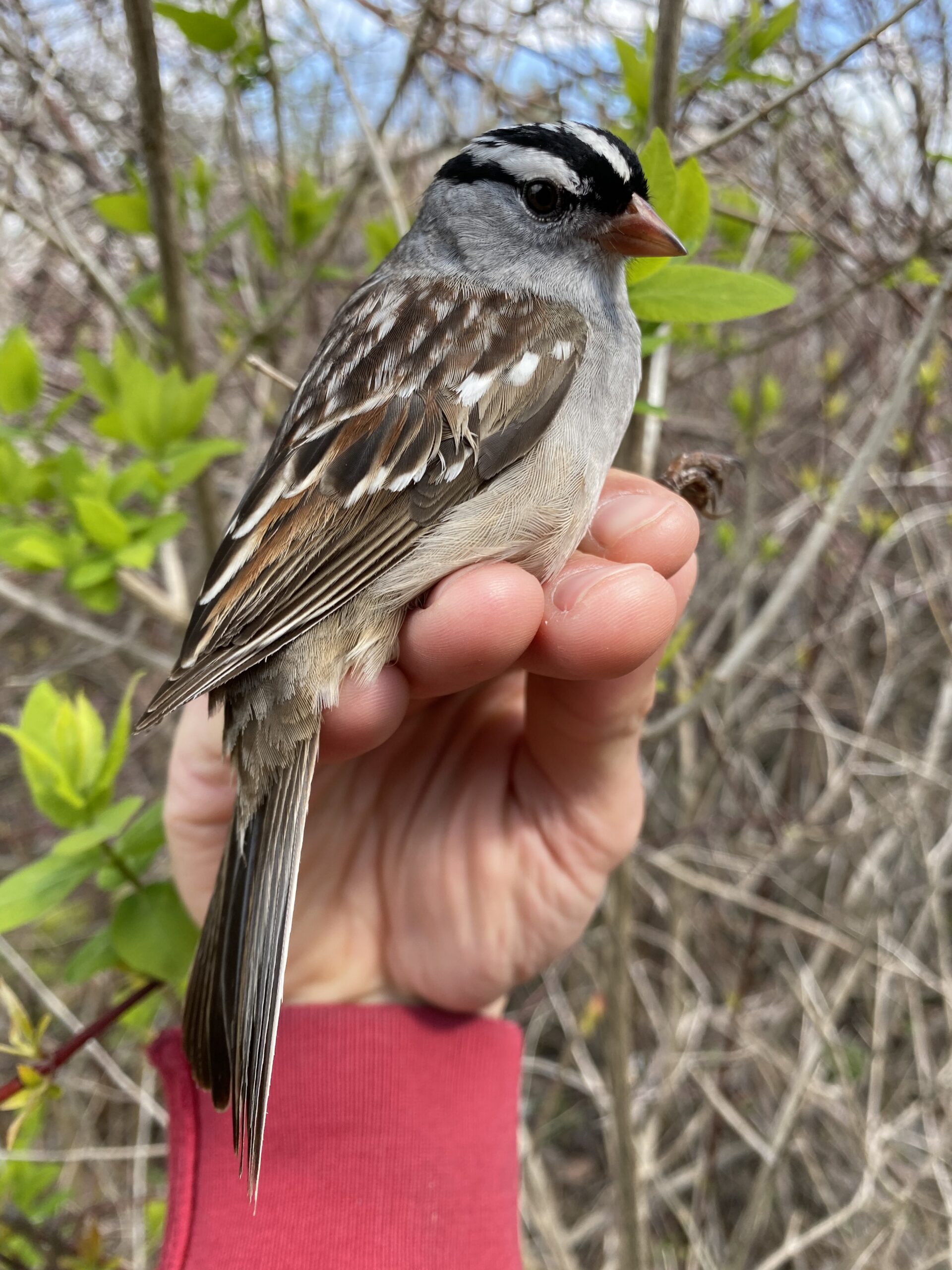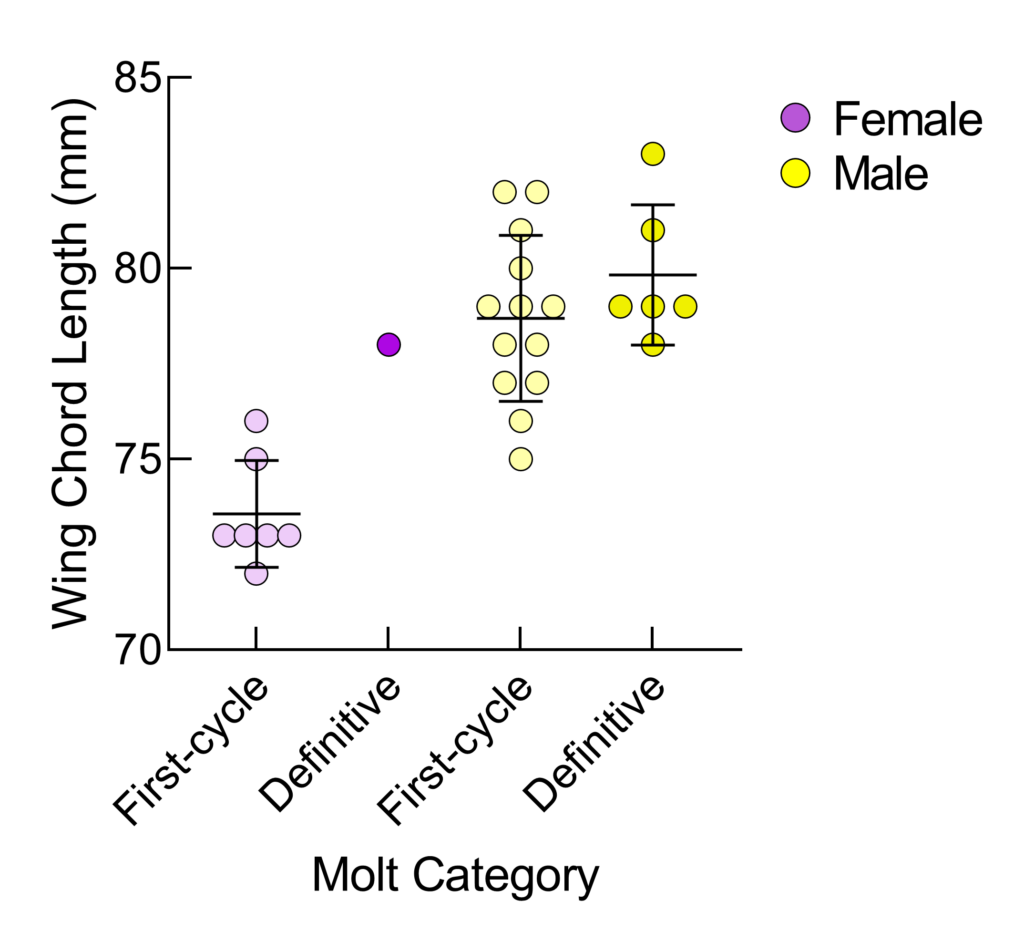The White-crowned Sparrow (Zonotrichia leucophrys) is a common, sexually monochromatic (male and female coloration is identical) songbird species that occurs across North America in different seasons. For this reason, it is one of the most commonly studied songbirds in North America. The White-crowned Sparrow has four currently recognized subspecies: Eastern (leucophrys), Gambel’s (gambelii), Nuttall’s (nuttalli), and Puget Sound (pugetensis). The Eastern subspecies is the most common subspecies in eastern North America and can be easily distinguished from the Gambel’s subspecies, which occurs rarely in eastern North America, by the presence of black in the lores (the dark line in front of the eye).
The most common method of sex determination in monochromatic bird species is by examining each individual for the presence of sex characteristics during the breeding season. However, birds lose their breeding characteristics after the breeding season has ended and only redevelop them at the start of the next breeding season. This means that monochromatic bird species cannot be sexed in the field during the pre-migratory, migratory, or overwintering periods, which presents a challenge for field biologists and bird banding stations. One method that can be used to determine sex in some monochromatic bird species is by using wing chord length. It was previously believed that the Eastern White-crowned Sparrow could not be reliably sexed using wing chord length, however, recent studies have shown that the Gambel’s and Puget Sound subspecies can be reliably sexed using wing chord length. After the findings of those studies, and after personal observations in the field, we decided to test if the Eastern White-crowned Sparrow could be reliably sexed using wing chord length.
We measured the wing chord lengths of Eastern White-crowned Sparrows at Long Point Bird Observatory and used PCR in the lab to determine the sex of each individual from either blood or feather samples. We sampled 38 individuals but were only able to determine the sex of 27 individuals. The majority of those (20) were individuals in first-cycle plumage (i.e., <1 year old), so we only tested for wing chord length differences in those birds.
We found that Eastern White-crowned Sparrows in first-cycle plumage can be reliably sexed by wing chord length outside of an overlapping range (74 – 76 mm) where sex cannot be reliably determined by wing chord length alone. Males can be reliably sexed with wing chord lengths of ≥ 77 mm and females can be reliably sexed with wing chord lengths ≤ 73 mm. To demonstrate how effectiveness of the tool we have created, we determined the proportion of individuals that can be reliably sexed using wing chord length from banding data at Long Point Bird Observatory between 2015 and 2022. We found that nearly two-thirds (63.8%) of birds in first-cycle plumage could be reliably sexed using wing chord length.
Our results provide a tool for field biologists and banding stations to sex Eastern White-crowned Sparrows in the field outside of their breeding season and also open avenues for future research on this subspecies as researchers can use the tool we have created to test for sex differences in other aspects of this subspecies’ biology.
Ryan A.C. Leys
Department of Biology, University of Waterloo, Waterloo, Ontario, Canada
The results of this study were recently published in the Journal of Field Ornithology:
Leys, R. A. C., and L. A. Grieves. 2023. Sex determination of Eastern White-crowned Sparrows (Zonotrichia leucophrys leucophrys) using wing chord length. Journal of Field Ornithology 94(3):2. https://doi.org/10.5751/JFO-00301-940302.
Header photo: Eastern White-crowned Sparrow (Zonotrichia leucophrys leucophrys) in the hand. Photo by Brownyn8/Getty images



